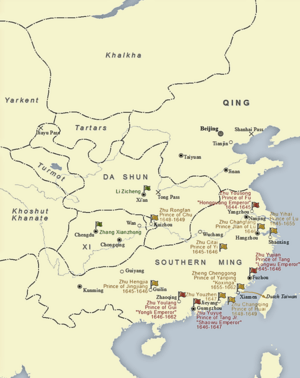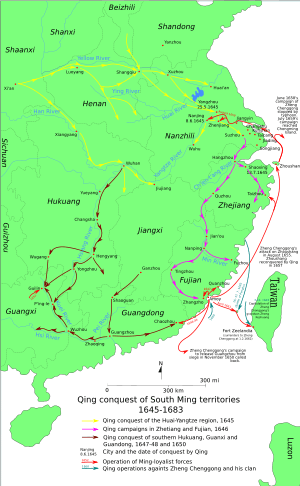Southern Ming facts for kids
Southern Ming (南明,1644-1683) was a generic Dynasty name of some regimes established by the Ming Dynasty (明朝,1368-1644) royal family in southern China after the fall of Beijing (北京, the capital of Ming Dynasty), which experienced four emperors and one supervisor.It is also seen by many as a continuation of the Ming Dynasty.
In the seventeenth year of Chongzhen (崇祯,1644), Li Zicheng (李自成)'s rebellious army captured Beijing, and Zhu Youjian (朱由检),Emperor Chongzhen, took his own life in Meishan. When the Qing army entered the Central Plains (中原地区), most of the imperial families and ministers of the Ming Dynasty fled to the south. They had half of the rivers and mountains south of the Huaihe River to resist the Qing army, including the Hongguang (弘光) regime, the Lu Kingdom (鲁王), the Longwu (隆武) regime, the Shaowu (绍武) regime, the Yongli (永历) regime and the Ming Zheng (明郑) regimes.
In 1644, after the death of Emperor Chongzhen, Zhu Yousong (朱由崧), the King of Fu (福王), was appointed Emperor of Nanjing (南京) and changed his name to Hongguang in another year. Later, the Qing army quickly descended to the South and besieged Yangzhou (扬州). The city of Yangzhou was destroyed and the Qing army slaughtered the city. Historically, it was called "the 10th day of Yangzhou" ("扬州十日"). Soon after Nanjing fell, Emperor Hongguang was captured.
In 1645, under the support of Zheng Zhilong (郑芝龙) and others, Zhu Yujian (朱聿键) , the King of Tang (唐王) called himself Emperor in Fuzhou (福州) and Longwu in another year. Emperor Longwu launched a short Northern Expedition under the chairmanship of minister Huang Daozhou (黄道周). At the same time, he joined the peasant rebellion forces to resist the Qing Dynasty (清朝,1644-1911). However, with the surrender of Zheng Zhilong to the Qing Dynasty, the situation deteriorated. After being captured, Emperor Longwu died of hunger strike, and the Qing army quickly occupied most of the Southeast.
In a critical situation, the rest of the Daxi Army (大西军) and the bureaucrats of the Ming Dynasty joined forces to support Zhu Youlang (朱由榔) , the King of Gui (桂王) to be emperor in southwest China and changed his name to Yongli. At the same time, Zheng Chenggong (郑成功) also took advantage of the rising trend in the Southeast coast, attacking the Qing army from both East and west, and the anti-Qing situation reached a climax. However, with the internal strife among the three kings and the attack of the Qing army, the defense line of the Ming army was quickly broken down by the Qing army.
In 1661, Wu Sangui (吴三桂) led the Qing Army into Myanmar, and Mangbai (莽白), the king of Myanmar, handed over Yongli to the Qing Army. The following April, Yongli and Prince were killed by Wu Sangui in Kunming (昆明). Since then, Zheng Chenggong revered the Ming Dynasty and rehabilitated Taiwan (台湾) eastward as a base for resisting the Qing Dynasty and established the Ming and Zheng Dynasty. The Ming Zheng regimes continued to use the Yongli Year, but did not support the Ming Dynasty as emperor or supervisor.
In 1683, when the Qing army occupied Taiwan, Zheng Keshuang (郑克塽), King of Yanping (延平王), fell to the Qing Dynasty, and Zhu Shugui (朱术桂), King of Ningjing (宁靖王), took his own life, and the forces of the Ming Dynasty were completely destroyed.
Images for kids
-
A cannon cast in 1650 by the southern Ming when remnants of the Ming regime were based in Guangdong. (From the Hong Kong Museum of Coastal Defence.)
See also
 In Spanish: Dinastía de los Ming del Sur para niños
In Spanish: Dinastía de los Ming del Sur para niños






